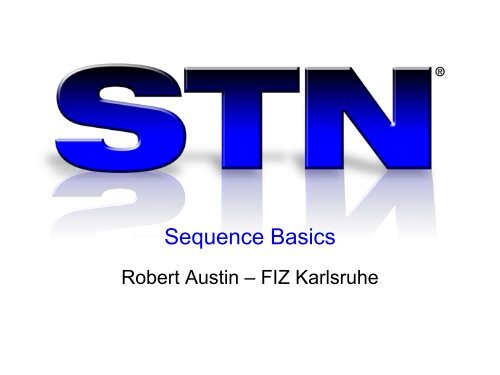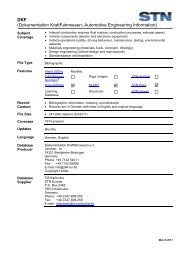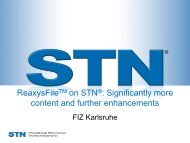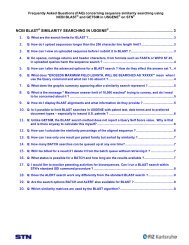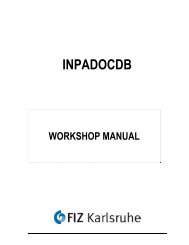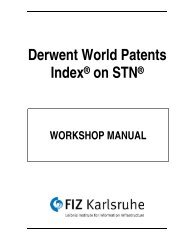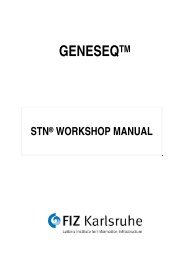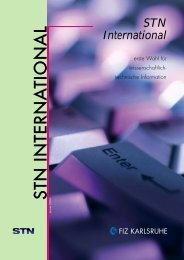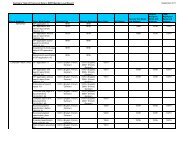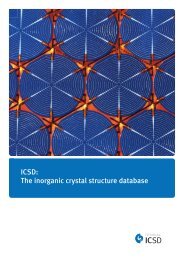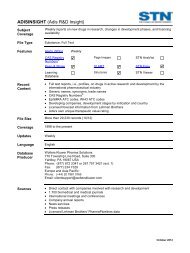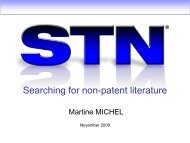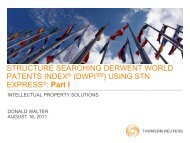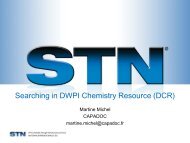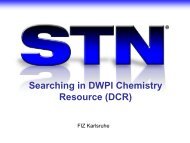Sequence Basics on STN - SequenceBase
Sequence Basics on STN - SequenceBase
Sequence Basics on STN - SequenceBase
You also want an ePaper? Increase the reach of your titles
YUMPU automatically turns print PDFs into web optimized ePapers that Google loves.
<str<strong>on</strong>g>Sequence</str<strong>on</strong>g> <str<strong>on</strong>g>Basics</str<strong>on</strong>g><br />
Robert Austin – FIZ Karlsruhe
Agenda<br />
• <str<strong>on</strong>g>Sequence</str<strong>on</strong>g> searchable databases <strong>on</strong> <strong>STN</strong> ®<br />
• BLAST in DGENE, USGENE ® and PCTGEN<br />
• CAS REGISTRY SM BLAST<br />
• <str<strong>on</strong>g>Sequence</str<strong>on</strong>g> code match (motif) searching<br />
• Recent enhancements<br />
2
<strong>STN</strong> ® sequence searchable databases<br />
• DGENE<br />
– Thoms<strong>on</strong> Reuters GENESEQ TM<br />
– Value-added patent sequence data from around the globe<br />
• USGENE<br />
– The USPTO Genetic <str<strong>on</strong>g>Sequence</str<strong>on</strong>g> Database<br />
– All available sequence data from the USPTO<br />
• PCTGEN<br />
– WIPO/PCT Patent Applicati<strong>on</strong> Biosequences<br />
– All available e-published sequence data from WIPO<br />
• CAS REGISTRY<br />
– Chemical Abstracts Service (CAS) REGISTRY<br />
– Worldwide value-added patent and n<strong>on</strong>-patent sequences<br />
3
DGENE, USGENE and PCTGEN all offer<br />
the same sequence search opti<strong>on</strong>s<br />
• BLAST similarity<br />
– RUN BLAST<br />
• <str<strong>on</strong>g>Sequence</str<strong>on</strong>g> Code Match (motif) searching<br />
– RUN GETSEQ<br />
• FASTA similarity<br />
– RUN GETSIM<br />
Enhanced!<br />
Note: this <str<strong>on</strong>g>Sequence</str<strong>on</strong>g> <str<strong>on</strong>g>Basics</str<strong>on</strong>g> e-Seminar<br />
covers RUN BLAST and RUN GETSEQ.<br />
4
The 7 basic steps of RUN BLAST<br />
1) SAVE, UPLOAD, and VERIFY the query (L1)<br />
2) RUN the BLAST search (/SQP, /SQN, /TSQN)<br />
3) Decide how many answers to keep (L2)<br />
4) SORT SCORE in Descending order (L3)<br />
5) Review answers in a free-of-charge format<br />
e.g. D L3 TRIAL SCORE ALIGN 1-<br />
6) Display selected answers in bibliographic<br />
format, e.g. D L3 BIB AB ALIGN 1,3,10<br />
7) Ensure transcript was captured before logoff<br />
5
The 7 basic steps of RUN BLAST<br />
Search Questi<strong>on</strong>:<br />
Find relevant U.S. published applicati<strong>on</strong> and<br />
patent references for this protein sequence:<br />
1 vqtvplsrlf dhamleahra helaidtyqe feetyipkdq kysflhdsqt<br />
51 sfcfsdsipt psnmeetqqk snlellrisl llieswlepv rflrsmfann<br />
101 lvydtsdsdd yhllkdleeg iqtlmgrled gsrrtgqilk qtyskfdtns<br />
151 hnhdallkny gllycfrkdm dkvetflrmv qcrsvegscg f<br />
See also: USGENE <strong>STN</strong> Workshop Manual:<br />
http://www.stn-internati<strong>on</strong>al.com/usgene_wm.html<br />
6
1) SAVE, UPLOAD and VERIFY the query<br />
• Prepare and save the query as a plain text file in<br />
a suitable text editor, e.g. Windows Notepad<br />
7
1) SAVE, UPLOAD and VERIFY the query (c<strong>on</strong>t.)<br />
(a) Click Upload <str<strong>on</strong>g>Sequence</str<strong>on</strong>g><br />
(b) Choose the query file<br />
(c) Select the <strong>STN</strong> database<br />
(a)<br />
From the Discover! butt<strong>on</strong> menu.<br />
(b)<br />
(c)<br />
The sequence becomes a Query<br />
L-number in the database of<br />
choice for use with RUN BLAST.<br />
8
1) SAVE, UPLOAD and VERIFY the query (c<strong>on</strong>t.)<br />
=> FILE USGENE<br />
=> UPL R BLAST<br />
Uploading C:\Documents and Settings\....\SEVEN STEPS EXAMPLE.txt<br />
UPLOAD SUCCESSFULLY COMPLETED<br />
L1 GENERATED<br />
=> D L1 LQUE<br />
Commands in red are automatically run by the<br />
<strong>STN</strong> Express <str<strong>on</strong>g>Sequence</str<strong>on</strong>g> Query Upload wizard.<br />
Verify the sequence was uploaded<br />
successfully with D LQUE.<br />
L1 ANSWER 1 USGENE COPYRIGHT 2010 SEQUENCEBASE CORP <strong>on</strong> <strong>STN</strong><br />
LQUE vqtvplsrlfdhamleahrahelaidtyqefeetyipkdqkysflhdsqtsfcfsdsi<br />
ptpsnmeetqqksnlellrislllieswlepvrflrsmfannlvydtsdsddyhllkd<br />
leegiqtlmgrledgsrrtgqilkqtyskfdtnshnhdallknygllycfrkdmdkve<br />
tflrmvqcrsvegscgf<br />
The sequence query is now ready for searching<br />
directly in USGENE using the L-number (L1).<br />
9
The 7 basic steps of RUN BLAST<br />
2) RUN the BLAST search<br />
� Protein search: RUN BLAST L1 /SQP<br />
� Nucleotide search: RUN BLAST L1 /SQN<br />
� Translated search: RUN BLAST L1 /TSQN<br />
10
=> FILE USGENE<br />
2) RUN the BLAST search<br />
FILE 'USGENE' ENTERED AT 17:40:40 ON 31 MAY 2010<br />
COPYRIGHT (C) 2010 SEQUENCEBASE CORP<br />
FILE LAST UPDATED: 28 MAY 2010 <br />
MOST RECENT PUBLICATION DATE: 27 MAY 2010 <br />
FILE COVERS 1981 TO DATE<br />
>>> FOR THE LATEST USGENE <strong>STN</strong> USER DOCUMENTATION, PLEASE VISIT:<br />
http://www.stn-internati<strong>on</strong>al.com/stn_biosequence_searching_usgene.html<br />
=> RUN BLAST L1 /SQP -F F<br />
BLAST Versi<strong>on</strong> 2.2<br />
The BLAST software is used herein with permissi<strong>on</strong> of the<br />
Nati<strong>on</strong>al Center for Biotechnology Informati<strong>on</strong> (NCBI) of<br />
the Nati<strong>on</strong>al Library of Medicine (NLM). See also, . . . .<br />
BLAST SEARCHING . . . .<br />
USGENE is updated within 3 days<br />
of publicati<strong>on</strong> by the USPTO.<br />
Turn the Low Complexity Filter<br />
off with the syntax: /SQP –F F<br />
11
RUN BLAST advanced opti<strong>on</strong>s<br />
Expectati<strong>on</strong> Value (-E)<br />
Expectati<strong>on</strong> value (E-Value) is the statistical significance<br />
threshold for reporting matches against a sequence database.<br />
The E-value can be any positive number, and the default value is<br />
10. This means that 10 matches may be expected to be found<br />
merely by chance. In general E-value is lowered to make the<br />
search more precise and raised to retrieve more answers.<br />
Word Size (-W)<br />
Word Size is the length of the character string fragments of a<br />
sequence query which are used as the basis for a BLAST<br />
search. For SQN the default is 11 and the range 7-23. For all<br />
other BLAST searches the default is 3 and the range 2-3. For<br />
short search queries, reducing the default word size can give<br />
improved search results.<br />
12
RUN BLAST advanced opti<strong>on</strong>s (c<strong>on</strong>t.)<br />
Low Complexity Filtering (<strong>on</strong> by default) (-F)<br />
The low complexity filter can eliminate biologically<br />
uninteresting segments that have low compositi<strong>on</strong>al<br />
complexity and are statistically significant, as determined<br />
by specific programs for peptide or nucleotide sequences in<br />
nature. Filtering is applied to the query sequence and is<br />
indicated by a series of Xs for peptide sequences and Ns<br />
for nucleotide sequences. Low complexity filtering can be<br />
turned off (i.e. set to F - false).<br />
Peptide similarity matrices (-M)<br />
For peptide based searches SQP and TSQN the advanced<br />
opti<strong>on</strong>s provide additi<strong>on</strong>al scoring matrices to the default<br />
BLOSUM62 (next slide).<br />
13
NCBI guidelines* for selecting the best<br />
peptide scoring matrix are as follows:<br />
Query Length Matrix Gap/extensi<strong>on</strong> costs<br />
85 BLOSUM-62 (11,1) (BLAST default)<br />
Tip: type HELP OPTIONS in USGENE for more<br />
informati<strong>on</strong> <strong>on</strong> using BLAST advanced opti<strong>on</strong>s.<br />
* http://www.ncbi.nlm.nih.gov/BLAST/matrix_info.html<br />
14
The 7 basic steps of RUN BLAST<br />
3) Decide how many answers to keep (L2)<br />
� After the BLAST search, <strong>STN</strong> provides a chart<br />
summarizing the results, and asks this questi<strong>on</strong>:<br />
ENTER EITHER THE NUMBER OF ANSWERS YOU WISH<br />
TO KEEP OR ENTER MINIMUM PERCENT OF SELF<br />
SCORE FOLLOWED BY %<br />
(BEST ANSWER PERCENTAGE OF SELF SCORE IS nnn%)<br />
ENTER (ALL) OR ? :<br />
� General recommendati<strong>on</strong>: Keep ALL answers, or<br />
use BATCH mode* to enable multiple retrievals<br />
* See page 115-119: http://www.stn-internati<strong>on</strong>al.com/usgene_wm.html<br />
15
The 7 basic steps of RUN BLAST<br />
4) SORT by SCORE descending (L3)<br />
� Sort the BLAST results answer set:<br />
=> SOR L2 SCORE D<br />
� Opti<strong>on</strong>: limit using text terms and/or dates (L4)<br />
� Remember to => SORT L4 SCORE D !! (L5)<br />
16
4384 ANSWERS FOUND BELOW EXPECTATION VALUE OF 10.0<br />
Similarity<br />
Score<br />
390 |<br />
|<br />
|<br />
3) Decide how many answers to keep<br />
QUERY SELF SCORE VALUE IS 390<br />
BEST ANSWER SCORE VALUE IS 390<br />
||||||||||||||||||||||||||||||||||||||<br />
|||||||||||||||||||||||||||||||||||||||<br />
The Query Self Score is the ideal<br />
score for a perfect answer match.<br />
The Best Answer Score is also<br />
given (in this example there is at<br />
least <strong>on</strong>e perfect answer match.)<br />
||||||||||||||||||||||||||||||||||||||||<br />
|||||||||||||||||||||||||||||||||||||||||<br />
||||||||||||||||||||||||||||||||||||||||||<br />
195 ||||||||||||||||||||||||||||||||||||||||||<br />
||||||||||||||||||||||||||||||||||||||||||<br />
|||||||||||||||||||||||||||||||||||||||||||<br />
|||||||||||||||||||||||||||||||||||||||||||<br />
||||||||||||||||||||||||||||||||||||||||||||<br />
||||||||||||||||||||||||||||||||||||||||||||||<br />
||||||||||||||||||||||||||||||||||||||||||||||||||<br />
||||||||||||||||||||||||||||||||||||||||||||||||||<br />
Answer Count 880 1760 2640 3520 4400<br />
The graphic representati<strong>on</strong> gives a count of<br />
hit sequences (x-axis) and similarity score<br />
(y-axis). The graph gives a visual clue<br />
about the distributi<strong>on</strong> of similar and not so<br />
similar sequences in the answer set.<br />
(C<strong>on</strong>t . . .)<br />
17
4) SORT by SCORE descending<br />
ENTER EITHER THE NUMBER OF ANSWERS YOU WISH TO KEEP<br />
OR ENTER MINIMUM PERCENT OF SELF SCORE FOLLOWED BY %<br />
(BEST ANSWER PERCENTAGE OF SELF SCORE IS 100%)<br />
ENTER (ALL) OR ? :85%<br />
L2 RUN STATEMENT CREATED<br />
L2 951 VQTVPLSRLFDHAMLEAHRAHELAIDTYQEFEETYIPKDQKYSFLHDSQT<br />
SFCFSDSIPTPSNMEETQQKSNLELLRISLLLIESWLEPVRFLRSMFANN<br />
LVYDTSDSDDYHLLKDLEEGIQTLMGRLEDGSRRTGQILKQTYSKFDTNS<br />
HNHDALLKNYGLLYCFRKDMDKVETFLRMVQCRSVEGSCGF/SQP.-F F<br />
Answer set arranged by accessi<strong>on</strong> number; to sort by descending<br />
similarity score, enter at an arrow prompt (=>) "sor score d".<br />
=> SOR SCORE D<br />
PROCESSING COMPLETED FOR L2<br />
L3 951 SOR L2 SCORE D<br />
In this example, 85% of the Query<br />
Self Score is used to select out<br />
just the most relevant results (L2).<br />
Use SORT SCORE D to sort<br />
by descending BLAST score.<br />
18
The 7 basic steps of RUN BLAST<br />
5) Review answers using a free-of-charge format<br />
including alignment (ALIGN), while “parked” in<br />
the <strong>STN</strong>GUIDE SM file<br />
� D L3 TRIAL SCORE ALIGN 1-<br />
� FILE <strong>STN</strong>GUIDE<br />
Note: the SCORE display field also includes the percentage<br />
of the Query Self Score (maximum possible BLAST score).<br />
19
5) Review answers with a free-of-charge<br />
format including alignment<br />
=> D L3 TRIAL SCORE ALIGN 1-150; FILE <strong>STN</strong>GUIDE<br />
L3 ANSWER 1 OF 951 USGENE COPYRIGHT 2010 SEQUENCEBASE CORP <strong>on</strong> <strong>STN</strong><br />
TI Recombinant DNA transfer vectors (Patent)<br />
MTY Protein<br />
SQL 191<br />
SCORE 390 100% of query self score 390<br />
BLASTALIGN<br />
Query = 191 letters<br />
Length = 191<br />
Score = 390 bits (1001), Expect = e-113<br />
Identities = 191/191 (100%), Positives = 191/191 (100%)<br />
This perfect match<br />
top hit comes from a<br />
U.S. issued patent.<br />
The SCORE display field includes the<br />
percentage of the Query Self Score.<br />
Query: 1 VQTVPLSRLFDHAMLEAHRAHELAIDTYQEFEETYIPKDQKYSFLHDSQTSFCFSDSIPT<br />
VQTVPLSRLFDHAMLEAHRAHELAIDTYQEFEETYIPKDQKYSFLHDSQTSFCFSDSIPT<br />
Sbjct: 1 VQTVPLSRLFDHAMLEAHRAHELAIDTYQEFEETYIPKDQKYSFLHDSQTSFCFSDSIPT<br />
Query: 61 PSNMEETQQKSNLELLRISLLLIESWLEPVRFLRSMFANNLVYDTSDSDDYHLLKDLEEG<br />
PSNMEETQQKSNLELLRISLLLIESWLEPVRFLRSMFANNLVYDTSDSDDYHLLKDLEEG<br />
Sbjct: 61 PSNMEETQQKSNLELLRISLLLIESWLEPVRFLRSMFANNLVYDTSDSDDYHLLKDLEEG<br />
Query: 121 IQTLMGRLEDGSRRTGQILKQTYSKFDTNSHNHDALLKNYGLLYCFRKDM . . . .<br />
IQTLMGRLEDGSRRTGQILKQTYSKFDTNSHNHDALLKNYGLLYCFRKDM<br />
Sbjct: 121 IQTLMGRLEDGSRRTGQILKQTYSKFDTNSHNHDALLKNYGLLYCFRKDM . . . .<br />
20
5) Review answers with a free-of-charge<br />
format including alignment<br />
L3 ANSWER 5 OF 951 USGENE COPYRIGHT 2010 SEQUENCEBASE CORP <strong>on</strong> <strong>STN</strong><br />
TI METHOD OF IMPROVING EFFICACY OF BIOLOGICAL RESPONSE-MODIFYING<br />
PROTEINS AND THE EXEMPLARY MUTEINS (PublishedApplicati<strong>on</strong>)<br />
DESC Artificial Protein; PL 10th, 31st, 44th, 52nd, 54th, 92nd, 97th,<br />
146th, 166th, 176th or 191st Phe is replaced by Val; sequence 23 of<br />
65<br />
MTY Protein<br />
SQL 191<br />
SCORE 387 99% of query self score 390<br />
BLASTALIGN<br />
Query = 191 letters<br />
Length = 191<br />
Score = 387 bits (995), Expect = e-113<br />
The 5th from top hit<br />
comes from a U.S.<br />
published applicati<strong>on</strong>.<br />
BLAST alignment<br />
details are explained<br />
<strong>on</strong> the next slide. . . .<br />
Identities = 189/191 (98%), Positives = 191/191 (99%)<br />
Query: 1 VQTVPLSRLFDHAMLEAHRAHELAIDTYQEFEETYIPKDQKYSFLHDSQTSFCFSDSIPT<br />
VQTVPLSRLFDHAML+AHRAH+LAIDTYQEFEETYIPKDQKYSFLHDSQTSFCFSDSIPT<br />
Sbjct: 1 VQTVPLSRLFDHAMLQAHRAHQLAIDTYQEFEETYIPKDQKYSFLHDSQTSFCFSDSIPT<br />
Query: 61 PSNMEETQQKSNLELLRISLLLIESWLEPVRFLRSMFANNLVYDTSDSDDY . . . .<br />
PSNMEETQQKSNLELLRISLLLIESWLEPVRFLRSMFANNLVYDTSDSDDY<br />
Sbjct: 61 PSNMEETQQKSNLELLRISLLLIESWLEPVRFLRSMFANNLVYDTSDSDDY . . . .<br />
21
Understanding BLAST alignments<br />
Query the length of the query sequence<br />
Length the length of the answer sequence<br />
Score a relative score assigned by BLAST<br />
Expect Expectati<strong>on</strong> Value – a value representing the<br />
chance that an answer is a random hit. The closer<br />
to zero, the less likely the hit is random<br />
Identities the number of exact letter matches between query<br />
and answer within the displayed local alignment.<br />
The amino acid letter is repeated* in the display<br />
Positives a combinati<strong>on</strong> of identities and amino acid family<br />
matches shown with + (plus) in the alignment<br />
Gaps shown as dashes - where BLAST must break the<br />
query or answer to maintain an alignment<br />
(* For nucleic acid searches a vertical bar is used to indicate nucleotide identities in the alignment display.)<br />
22
Opti<strong>on</strong>: refine BLAST results with additi<strong>on</strong>al<br />
text and/or date search terms<br />
ENTER EITHER THE NUMBER OF ANSWERS YOU WISH TO KEEP<br />
OR ENTER MINIMUM PERCENT OF SELF SCORE FOLLOWED BY %<br />
(BEST ANSWER PERCENTAGE OF SELF SCORE IS 100%)<br />
ENTER (ALL) OR ? :85%<br />
L2 RUN STATEMENT CREATED<br />
L2 951 VQTVPLSRLFDHAMLEAHRAHELAIDTYQEFEETYIPKDQKYSFLHDSQT<br />
SFCFSDSIPTPSNMEETQQKSNLELLRISLLLIESWLEPVRFLRSMFANN<br />
LVYDTSDSDDYHLLKDLEEGIQTLMGRLEDGSRRTGQILKQTYSKFDTNS<br />
HNHDALLKNYGLLYCFRKDMDKVETFLRMVQCRSVEGSCGF/SQP.-F F<br />
Answer set arranged by accessi<strong>on</strong> number; to sort by descending<br />
similarity score, enter at an arrow prompt (=>) "sor score d".<br />
=> SOR SCORE D<br />
PROCESSING COMPLETED FOR L2<br />
L3 951 SOR L2 SCORE D<br />
=> S L2 AND AY
The 7 basic steps of RUN BLAST<br />
6) Display selected relevant answers in a<br />
bibliographic format including alignment<br />
� E.g. => D L5 BIB AB SCORE ALIGN 1,3,10<br />
24
6) Display selected answers in a preferred<br />
bibliographic format<br />
=> D BIB AB SCORE ALIGN 1 4<br />
L5 ANSWER 1 OF 20 USGENE COPYRIGHT 2010 SEQUENCEBASE CORP <strong>on</strong> <strong>STN</strong><br />
AN 4363877.1 Protein USGENE<br />
TI Recombinant DNA transfer vectors (Patent)<br />
IN Goodman Howard M. (San Francisco, CA); Shine John (San Francisco,<br />
This sequence comes from<br />
a U.S. granted patent, with<br />
an applicati<strong>on</strong> date prior to<br />
2001.<br />
CA); Seeburg Peter H. (San Francisco, CA)<br />
PA The Regents of the University of California(Berkeley CA)<br />
PI US 4363877 A 19821214<br />
AI US 1978-897710 19780419<br />
AB Recombinant DNA transfer vectors c<strong>on</strong>taining cod<strong>on</strong>s for human<br />
somatomammotropin and for human growth horm<strong>on</strong>e.<br />
SCORE 390 100% of query self score 390<br />
BLASTALIGN<br />
Query = 191 letters<br />
Length = 191<br />
Score = 390 bits (1001), Expect = e-113<br />
REGISTRY.<br />
Identities = 191/191 (100%), Positives = 191/191 (100%)<br />
Query: 1 VQTVPLSRLFDHAMLEAHRAHELAIDTYQEFEETYIPKDQKYSFLHDSQTSF . . . .<br />
VQTVPLSRLFDHAMLEAHRAHELAIDTYQEFEETYIPKDQKYSFLHDSQTSF<br />
Sbjct: 1 VQTVPLSRLFDHAMLEAHRAHELAIDTYQEFEETYIPKDQKYSFLHDSQTSF . . . .<br />
Note: this USGENE record<br />
is an example of <strong>on</strong>e which<br />
is not present in DGENE or<br />
25
6) Display selected answers in a preferred<br />
bibliographic format<br />
L5 ANSWER 4 OF 20 USGENE COPYRIGHT 2010 SEQUENCEBASE CORP <strong>on</strong> <strong>STN</strong><br />
AN 6010999.4 protein USGENE<br />
TI Stabilizati<strong>on</strong> of fibroblast growth factors by modificati<strong>on</strong> of<br />
cysteine residues (Patent)<br />
IN Daley Michael Joseph (Yardley, PA); Buckwalter Brian Lee (Yardley,<br />
This sequence also comes<br />
PA); Cady Susan Mancini (Yardley, PA); Shieh H<strong>on</strong>g-Ming (Langforne,<br />
PA); Bohlen Peter (Peekskill, NY); Sedd<strong>on</strong> Andrew P. (M<strong>on</strong>roe, NY)<br />
PA American Cyanamid Company (Madis<strong>on</strong> NJ)<br />
PI US 6010999 A 20000104<br />
AI US 1995-459906 19950602<br />
DT Patent<br />
AB The present inventi<strong>on</strong> relates to physiologically-active derivatized<br />
natural and recombinant mammalian and human proteins and . . .<br />
SCORE 331 84% of query self score 390<br />
BLASTALIGN<br />
Query = 191 letters<br />
Length = 194<br />
Score = 331 bits (849), Expect = 4e-96<br />
Identities = 162/189 (85%), Positives = 174/189 (91%)<br />
Query: 3 TVPLSRLFDHAMLEAHRAHELAIDTYQEFEETYIPKDQKYSFLHDSQTSFCF . . . .<br />
T+PLSRLFD+AML AHR H+LA DTYQEFEE YIPK+QKYSFL + QTS CF<br />
Sbjct: 6 TIPLSRLFDNAMLRAHRLHQLAFDTYQEFEEAYIPKEQKYSFLQNPQTSLCF . . . .<br />
from a U.S. granted patent,<br />
with an applicati<strong>on</strong> date<br />
prior to 2001.<br />
Note: this USGENE record<br />
is an example of <strong>on</strong>e which<br />
is not present in the NCBI or<br />
EMBL-EBI patent divisi<strong>on</strong>s.<br />
26
7) Ensure your <strong>STN</strong> Express sessi<strong>on</strong><br />
transcript was captured and then logoff<br />
Note: if you wish to save<br />
everything d<strong>on</strong>e prior to<br />
choosing “Capture<br />
Sessi<strong>on</strong>”, click the “Capture<br />
retrospectively” box, before<br />
clicking the “Open” butt<strong>on</strong>.<br />
27
The importance of using the correct BLAST<br />
settings opti<strong>on</strong>s<br />
=> RUN BLAST GSSFLSPEHQR/SQP<br />
. . . .<br />
NO ANSWERS FOUND BELOW EXPECTATION VALUE OF 10.0<br />
=> RUN BLAST GSSFLSPEHQR/SQP -M PAM30 -W 2 -E 20000 -F F<br />
. . . .<br />
8518 ANSWERS FOUND BELOW EXPECTATION VALUE OF 20000.0<br />
. . . .<br />
QUERY SELF SCORE VALUE IS 38<br />
BEST ANSWER SCORE VALUE IS 38<br />
ENTER EITHER THE NUMBER OF ANSWERS YOU WISH TO KEEP<br />
OR ENTER MINIMUM PERCENT OF SELF SCORE FOLLOWED BY %<br />
(BEST ANSWER PERCENTAGE OF SELF SCORE IS 100%)<br />
ENTER (ALL) OR ? :70%<br />
L1 RUN STATEMENT CREATED<br />
L1 2019 GSSFLSPEHQR/SQP.-M PAM30 -W 2 -E 20000 -F F<br />
Changing BLAST<br />
opti<strong>on</strong>s is especially<br />
important for short<br />
sequence queries.<br />
In this example, 70% of the Query Self<br />
Score is used to select relevant results (L1).<br />
28
The importance of using the correct BLAST<br />
advanced opti<strong>on</strong>s (c<strong>on</strong>t.)<br />
=> SOR L1 SCORE D<br />
PROCESSING COMPLETED FOR L1<br />
L2 2019 SOR L1 SCORE D<br />
=> D TRI SCORE ALIGN<br />
Correct use of BLAST opti<strong>on</strong>s<br />
finds relevant sequence hits.<br />
L2 ANSWER 1 OF 2019 USGENE COPYRIGHT 2010 SEQUENCEBASE CORP <strong>on</strong> <strong>STN</strong><br />
TI Anti-pro6094 antibodies (Patent)<br />
DESC Homo sapiens Protein; sequence 442 of 550<br />
MTY Protein<br />
SQL 117<br />
SCORE 38 100% of query self score 38<br />
BLASTALIGN<br />
Query = 11 letters<br />
Length = 117<br />
Score = 37.5 bits (81), Expect = 4e-09<br />
Identities = 11/11 (100%), Positives = 11/11 (100%)<br />
Query: 1 GSSFLSPEHQR 11<br />
GSSFLSPEHQR<br />
Sbjct: 24 GSSFLSPEHQR 34<br />
29
NCBI recommended settings* for searching<br />
small sequence queries<br />
Peptide sequences<br />
• E-value: 20,000<br />
• Word size: 2<br />
Nucleotide sequences<br />
• E-value: 1,000<br />
• Word size: 7<br />
* http://www.ncbi.nlm.nih.gov/blast/Why.shtml<br />
• Matrix: PAM-30<br />
• Gap cost: 9 and 1<br />
• Matrix: Leave as is<br />
• Gap cost: n/a<br />
30
Review: 7 steps of RUN BLAST<br />
1) SAVE, UPLOAD, and VERIFY the query (L1)<br />
2) RUN the BLAST search (/SQP, /SQN, /TSQN)<br />
3) Decide how many answers to keep (L2)<br />
4) SORT SCORE in Descending order (L3)<br />
5) Review answers in a free-of-charge format,<br />
e.g. D L3 TRIAL SCORE ALIGN 1-<br />
6) Display selected answers in bibliographic<br />
format, e.g. D L3 BIB AB ALIGN 1,3,10<br />
7) Ensure transcript was captured before logoff<br />
31
CAS REGISTRY BLAST searching<br />
Search Questi<strong>on</strong>:<br />
Locate references to Arginine Methyltransferase<br />
(RMT) protein sequence.<br />
32
CAS REGISTRY BLAST search steps<br />
1. Launch BLAST<br />
2. Search the sequence<br />
3. Examine and evaluate alignment/relevance of<br />
sequence answers<br />
4. Display <strong>STN</strong> data <strong>on</strong> sequences – REGISTRY<br />
5. Display <strong>STN</strong> data <strong>on</strong> sequences – CAplus SM<br />
– Limit CAplus results, if necessary<br />
– Display CAplus data (references and HITRN)<br />
6. Post-process BLAST alignment data<br />
33
Launch CAS REGISTRY BLAST<br />
• The Result Set Manager is<br />
the starting point<br />
• To begin a new sequence<br />
search<br />
• To review results of previous<br />
sequence searches<br />
34
Input the search query<br />
• <str<strong>on</strong>g>Sequence</str<strong>on</strong>g>s can be input by Copy/paste<br />
• Read from a file<br />
• Recall a previously searched sequence<br />
within the same sessi<strong>on</strong><br />
• <str<strong>on</strong>g>Sequence</str<strong>on</strong>g> line numbers do not<br />
interfere with the search.<br />
35
Select the BLAST program<br />
The following programs are<br />
most typically run:<br />
• BLASTn for nucleotides<br />
• BLASTp for proteins/peptides<br />
36
Verify BLAST settings<br />
Default values have been set to<br />
optimize sequence searches for<br />
researchers.<br />
Recommended settings for<br />
patent searches:<br />
• Low Complexity Filtering –<br />
unchecked<br />
• Max No. of Answers - 1000<br />
37
View results<br />
Highlight the result set<br />
to be viewed, and click<br />
<strong>on</strong> View Results.<br />
38
Evaluate the alignment report<br />
The negative sign represents<br />
that the alignment details are<br />
shown.<br />
Detail informati<strong>on</strong> such as the<br />
sequence length, score,<br />
percent identity are available.<br />
39
Select sequences of interest<br />
<str<strong>on</strong>g>Sequence</str<strong>on</strong>g>s can be selected:<br />
• In groups, using the color bar in the<br />
Alignment Scores<br />
• Individually, by selecting the check box<br />
• To transfer the sequence data to <strong>STN</strong>,<br />
click the Get <strong>STN</strong> Data butt<strong>on</strong>.<br />
40
Get <strong>STN</strong> Data and Save alignments (.xss)<br />
Alignment data needs<br />
to be transferred for<br />
post-processing.<br />
The alignment data is saved in <strong>STN</strong><br />
Express Saved <str<strong>on</strong>g>Sequence</str<strong>on</strong>g>s (.xss) format.<br />
41
Transfer sequences to <strong>STN</strong><br />
• Log<strong>on</strong> to <strong>STN</strong> and a REGISTRY search<br />
of the sequences is automatic.<br />
• Results display can be accomplished<br />
using either Discover! wizards or<br />
command line input.<br />
• Note: Type END or click Cancel to get<br />
out of the “Display Wizard”. You can turn<br />
off the “Display Wizard” in Preferences.<br />
Display sequences if desired.<br />
42
=> FILE CAPLUS<br />
=> S L6 AND NONPATENT/DT<br />
Crossover to CAplus<br />
L7 14 L6 AND NONPATENT/DT<br />
=> D L7 IBIB ABS HITRN 1-14<br />
=> S L6 AND PATENT/DT<br />
L8 20 L6 AND PATENT/DT<br />
=> FSORT L8<br />
L9 20 FSO L8<br />
3 Multi-record Families Answers 1-7<br />
Family 1 Answers 1-3<br />
Family 2 Answers 4-5<br />
Family 3 Answers 6-7<br />
13 Individual Records Answers 8-20<br />
0 N<strong>on</strong>-patent Records<br />
=> D L9 IBIB ABS HITRN 1-20<br />
Additi<strong>on</strong>al keyword refinement<br />
or other searches can be used<br />
in CAplus. In this example,<br />
patents and n<strong>on</strong>patents were<br />
separated in 2 L-numbers.<br />
C<strong>on</strong>sider SAVE or SAVE TEMP<br />
to keep your answer sets.<br />
43
Post-process BLAST alignments<br />
44
Select BLAST alignment reports<br />
• The first step is to select the XSS<br />
file to include in the BLAST report.<br />
• Important: If your BLAST query is<br />
fairly l<strong>on</strong>g, or a nucleic acid, or the<br />
answers may exceed 1000<br />
characters, make sure you change<br />
the value in the Do not include<br />
alignments l<strong>on</strong>ger than box.<br />
Post-processing then c<strong>on</strong>tinues<br />
via standard <strong>STN</strong> Express<br />
Custom Report Tool steps.<br />
45
Review – Similarity Search Strategy<br />
1. Launch BLAST<br />
2. Search the sequence<br />
3. Examine and evaluate alignment/relevance of<br />
sequence answers<br />
4. Display <strong>STN</strong> data <strong>on</strong> sequences – REGISTRY<br />
5. Display <strong>STN</strong> data <strong>on</strong> sequences – CAplus<br />
– Limit CAplus results, if necessary<br />
– Display CAplus data (references and HITRN)<br />
6. Post-process BLAST alignment data<br />
46
<str<strong>on</strong>g>Sequence</str<strong>on</strong>g> code match (motif) searching<br />
• GETSEQ is designed to retrieve either exact<br />
matches to a sequence query or answers with<br />
c<strong>on</strong>servative variati<strong>on</strong> using special symbols<br />
• It can also be used to retrieve exact length<br />
matches or subsequence hits, i.e. where the<br />
query is a small part of a larger hit sequence<br />
• GETSEQ can prove to be a fast, precise and<br />
effective alternative to BLAST for very short<br />
sequence queries, e.g. DNA probes and primers<br />
• A <str<strong>on</strong>g>Sequence</str<strong>on</strong>g> Code Match (SCM) search may be<br />
run in REGISTRY, but the SEARCH (=> S)<br />
command is used instead of RUN GETSEQ<br />
47
The RUN GETSEQ command<br />
=> RUN GETSEQ L1 (sequence or query L-number)<br />
/SQEP (exact protein) (default)<br />
/SQEFP (exact family protein)<br />
/SQSP (subsequence protein)<br />
/SQSFP (subsequence family protein)<br />
/SQEN (exact nucleotide)<br />
/SQSN (subsequence nucleotide)<br />
Note: an SCM search may also be run in REGISTRY, but the<br />
SEARCH (=> S) command is used instead of RUN GETSEQ.<br />
48
EXACT (/SQEN) and SUBSEQUENCE<br />
(/SQSN) nucleic acid searching<br />
=> RUN GETSEQ GCCGCCGT/SQEN<br />
L1 RUN STATEMENT CREATED<br />
L1 2 GCCGCCGT/SQEN<br />
=> D L1 1 SEQ SQL<br />
L1 ANSWER 1 OF 2 USGENE COPYRIGHT 2010 SEQUENCEBASE CORP <strong>on</strong> <strong>STN</strong><br />
SEQ 1 gccgccgt<br />
========<br />
HITS AT: 1-8<br />
SQL 8<br />
=> RUN GETSEQ ACCCTGCAAATAGCA/SQSN<br />
L2 RUN STATEMENT CREATED<br />
L2 49 ACCCTGCAAATAGCA/SQSN<br />
The SEQ display in USGENE<br />
shows the entire sequence with<br />
the hit nucleic acids underlined<br />
and identified by “HITS AT”.<br />
A SUBSEQENCE search also<br />
includes answers which are<br />
l<strong>on</strong>ger than the query sequence.<br />
=> D L2 30 SEQ SQL<br />
L2 ANSWER 30 OF 49 USGENE COPYRIGHT 2010 SEQUENCEBASE CORP <strong>on</strong> <strong>STN</strong><br />
SEQ 1 tgtagttcat tatcatcttt gtcatcagct gaagatgaaa taggatgtaa<br />
51 tcagacgaca caggaagcag attctgctaa taccctgcaa atagcaga<br />
========= ======<br />
HITS AT: 82-96<br />
SQL 98<br />
49
EXACT (/SQEP) and SUBSEQUENCE<br />
(/SQSP) protein searching<br />
=> RUN GETSEQ SMAEP/SQEP<br />
L3 RUN STATEMENT CREATED<br />
L3 3 SMAEP/SQEP<br />
=> D L3 1 SQL SEQ<br />
L3 ANSWER 1 OF 3 USGENE COPYRIGHT 2010 SEQUENCEBASE CORP <strong>on</strong> <strong>STN</strong><br />
SQL 5<br />
SEQ 1 smaep<br />
=====<br />
HITS AT: 1-5<br />
=> RUN GETSEQ KGPSYSLR/SQSP<br />
L4 RUN STATEMENT CREATED<br />
L4 102 KGPSYSLR/SQSP<br />
=> D L4 11 SQL SEQ<br />
L4 ANSWER 11 OF 102 USGENE COPYRIGHT 2010 SEQUENCEBASE CORP <strong>on</strong> <strong>STN</strong><br />
SQL 19<br />
SEQ 1 kgpsyslrst tmmirpldf<br />
========<br />
HITS AT: 1-8<br />
In all sequence databases, the typed<br />
order of the display fields will be the<br />
order that the fields are displayed.<br />
A SUBSEQENCE search also<br />
includes answers which are<br />
l<strong>on</strong>ger than the query sequence.<br />
50
EXACT (/SQEFP) and SUBSEQUENCE<br />
(/SQSFP) FAMILY protein searching<br />
=> RUN GETSEQ SMAEP/SQEFP<br />
L5 RUN STATEMENT CREATED<br />
L5 23 SMAEP/SQEFP<br />
=> D L5 2-3 SQL SEQ<br />
L5 ANSWER 2 OF 23 USGENE COPYRIGHT 2010 SEQUENCEBASE CORP <strong>on</strong> <strong>STN</strong><br />
SQL 5<br />
SEQ 1 gites<br />
=====<br />
HITS AT: 1-5<br />
=> RUN GETSEQ KGPSYSLR/SQSFP<br />
L6 RUN STATEMENT CREATED<br />
L6 2384 KGPSYSLR/SQSFP<br />
=> D L6 73 SEQ SQL<br />
SMAEP/SQEP retrieved 3 records (L3).<br />
SMAEP/SQEFP retrieved 23 records.<br />
Possible amino acid family<br />
substituti<strong>on</strong>s for SMAEP:<br />
S M A E P<br />
P I G Q A<br />
A L T N G<br />
G V P D S<br />
T S B T<br />
KGPSYSLR/SQSP retrieved 102 records (L4).<br />
KGPSYSLR/SQSFP retrieved 2384 records.<br />
L6 ANSWER 73 OF 2384 USGENE COPYRIGHT 2010 SEQUENCEBASE COR <strong>on</strong> <strong>STN</strong><br />
SQL 43<br />
SEQ 1 hfrgkfcgki apppvvssgp flfikfvsdy ethgagfsir yei<br />
========<br />
HITS AT: 33-40<br />
51
Amino acid families for RUN GETSEQ<br />
SQEFP and SQSFP search opti<strong>on</strong>s<br />
Neutral-Weak Hydrophobics<br />
Acid Amines-Hydrophilic<br />
Basic-Hydrophilic<br />
Hydrophobics<br />
Aromatic<br />
Cross-Linking<br />
GROUP AMINO ACIDS<br />
P, A, G, S, T<br />
Q, N, E, D, B, Z<br />
H, K, R<br />
I, M, L, V<br />
F, W, Y<br />
C<br />
52
Special variability symbols allow flexibility<br />
in RUN GETSEQ searching<br />
• Variability symbols (pattern matching):<br />
– Allow users to specify motif patterns that c<strong>on</strong>sist of<br />
different amino acid(s) at <strong>on</strong>e locati<strong>on</strong> of a sequence<br />
– Provide the ability to specify sequences separated by<br />
an unknown number of amino acids (gaps)<br />
– Provide the ability to search for sequence patterns at<br />
either beginning or the end of the sequence<br />
– Allow users to specify the number or range of repeats<br />
for amino acid(s) or gaps<br />
Note: a complete table of all variability symbols, with search examples, is<br />
given in the DGENE, USGENE and PCTGEN database summary sheets:<br />
http://www.stn-internati<strong>on</strong>al.com/stndatabases/databases/<strong>on</strong>lin_db.html<br />
53
Variability symbols for RUN GETSEQ<br />
Symbol Functi<strong>on</strong><br />
[ ] Specify alternate residues<br />
[-] Exclude a specific residue or alternate residues<br />
{ } Repeat the preceding symbol(s) (number or range)<br />
? Repeat the preceding symbol(s) zero or <strong>on</strong>e time<br />
* Repeat the preceding symbol(s) zero or more times<br />
+ Repeat the preceding symbol(s) <strong>on</strong>e or more times<br />
^ Query appears at the beginning or the end of a sequence<br />
| Alternate sequence expressi<strong>on</strong>s<br />
. A gap of <strong>on</strong>e residue<br />
: A gap of zero or <strong>on</strong>e residues<br />
& C<strong>on</strong>catenate (join together) sequence queries<br />
54
Using RUN GETSEQ variability symbols to<br />
search in USGENE and REGISTRY<br />
Search Questi<strong>on</strong>:<br />
Find patent references* disclosing <strong>on</strong>e or more of<br />
the sequences represented by this Markush<br />
peptide sequence formula:<br />
LGPX 1QLCX 2LVX 3CAP<br />
X 1 = V or L<br />
X 2 = any amino acid except, G or H<br />
X 3 = any amino acid<br />
55
RUN GETSEQ SCM search strategy<br />
=> RUN GETSEQ LGP[VL]QLC[-GH]LV.CAP/SQSP<br />
– Possible sequence retrieval<br />
• LGPVQLCALVHCAP<br />
• LGPVQLCSLVVCAP<br />
• LGPLQLCVLVACAP<br />
• LGPLQLCPLVTCAP<br />
Reminder: an SCM search may also be run in REGISTRY, but<br />
the SEARCH (=> S) command is used instead of RUN GETSEQ.<br />
56
Run the USGENE GETSEQ SCM search<br />
=> FILE USGENE<br />
=> RUN GETSEQ LGP[VL]QLC[-GH]LV.CAP/SQSP<br />
There are 17 sequence records<br />
L1 RUN STATEMENT CREATED<br />
in DGENE 32 sequence for CA2325774. hits (L1) have<br />
L1 32 LGP[VL]QLC[-GH]LV.CAP/SQSP been found in USGENE<br />
c<strong>on</strong>taining the sequence<br />
=> D TRI SEQ<br />
fragment(s) of interest.<br />
L1 ANSWER 1 OF 32 USGENE COPYRIGHT 2010 SEQUENCEBASE CORP <strong>on</strong> <strong>STN</strong><br />
TI Nucleotide and amino acid sequences, and assays and methods of use<br />
thereof for diagnosis of prostate cancer (Patent)<br />
MTY Protein<br />
SQL 417<br />
The hit porti<strong>on</strong> of the answer<br />
SEQ<br />
sequence is highlighted with<br />
double underlining.<br />
1 mrfawtvlll gplqlcalvh cappaagqqq ppreppaapg awrqqiqwen<br />
= ========== ===<br />
51 ngqvfsllsl gsqyqpqrrr dpgaavpgaa nasaqqprtp illirdnrta<br />
. . . .<br />
401 rytghhayas gctispy<br />
HITS AT: 10-23<br />
57
Repeat the USGENE search in REGISTRY<br />
and combine all results in CAplus SM<br />
=> FILE REGISTRY<br />
=> S L1<br />
L2 38 LGP[VL]QLC[-GH]LV.CAP/SQSP<br />
=> FIL HCAPLUS<br />
=> S L2 AND P/DT<br />
L3 28 L2 AND P/DT<br />
=> TRA PN L1<br />
L4 TRANSFER L1 1- PN : 30 TERMS<br />
L5 65 L4<br />
=> S L3 OR L5<br />
L6 75 L3 OR L5<br />
To repeat an SCM search<br />
in REGISTRY simply<br />
SEARCH the answer set<br />
L-number from USGENE.<br />
L3 = CAplus patent records<br />
found using REGISTRY.<br />
L5 = CAplus patent records<br />
found using USGENE.<br />
L6 = CAplus records found<br />
using both USGENE and<br />
REGISTRY in combinati<strong>on</strong>.<br />
=> S L6 AND (ANTIBOD### OR IMMUNOGLOBULIN#) AND DIAGNOS? AND<br />
PROSTAT? AND (CANCER? OR TUMOR? OR NEOPLAS?)<br />
L7 4 L6 AND (ANTIBOD### OR IMMUNOGLOBULIN#) AND DIAGNOS? AND<br />
PROSTAT? AND (CANCER? The CAplus OR TUMOR? search OR may NEOPLAS?) be further refined<br />
using CAS value-added abstracts and indexing.<br />
58
Use USGENE and REGISTRY in combinati<strong>on</strong><br />
to locate relevant CAplus records<br />
=> D L7 BIB ABS HITIND<br />
This example CAplus record was<br />
L7 ANSWER 1 OF 4 HCAPLUS COPYRIGHT 2010 ACS <strong>on</strong> <strong>STN</strong><br />
AN 2007:463771 HCAPLUS<br />
uniquely retrieved by the combinati<strong>on</strong><br />
TI Detecti<strong>on</strong> of tissue-derived glycoproteins of a USGENE shed into GETSEQ blood search serum in and the<br />
diagnosis and m<strong>on</strong>itoring of disease CAplus value-added indexing search.<br />
IN Zhang, Hui; Aebersold, Rudolf H.<br />
PA Institute for Systems Biology, USA<br />
. . . .<br />
FAN.CNT 1<br />
PATENT NO. KIND DATE APPLICATION NO. DATE<br />
--------------- ---- -------- -------------------- --------<br />
PI WO 2007047796 A2 20070426 WO 2006-US40784 20061017<br />
US 20070099251 A1 20070503 US 2006-582861 20061017
New opti<strong>on</strong> to SORT by BLAST percent identity<br />
(IDENT) in DGENE, USGENE, and PCTGEN<br />
• Useful for identifying short, highly similar<br />
sequences, that have a low overall BLAST<br />
similarity score, e.g., probes, primers<br />
• Useful for identifying short, highly similar areas<br />
within larger sequences, e.g., motifs, biomarkers<br />
• Opti<strong>on</strong> to double-sort in combinati<strong>on</strong> with the<br />
overall BLAST similarity score<br />
– User chooses which is the primary sort parameter<br />
Learn more about the new percent identity feature for sorting<br />
BLAST answer sets in DGENE, USGENE, and PCTGEN at:<br />
http://www.stn-internati<strong>on</strong>al.com/percent_identity_sorting.html<br />
60
Example: SORT by percent identity<br />
=> D IDENT SCORE 1-7<br />
L3 ANSWER 1 OF 446 USGENE COPYRIGHT 2010 SEQUENCEBASE CORP <strong>on</strong> <strong>STN</strong><br />
IDENT 100%<br />
SCORE 496 100% of query self score 496<br />
L3 ANSWER 2 OF 446 USGENE COPYRIGHT 2010 SEQUENCEBASE CORP <strong>on</strong> <strong>STN</strong><br />
IDENT 100%<br />
overall similarity.<br />
SCORE 496 100% of query self score 496<br />
● ● ●<br />
L3 ANSWER 5 OF 446 USGENE COPYRIGHT 2010 SEQUENCEBASE CORP <strong>on</strong> <strong>STN</strong><br />
IDENT 100%<br />
SCORE 98 19% of query self score 496<br />
L3 ANSWER 6 OF 446 USGENE COPYRIGHT 2010 SEQUENCEBASE CORP <strong>on</strong> <strong>STN</strong><br />
IDENT 100%<br />
SCORE 98 19% of query self score 496<br />
<str<strong>on</strong>g>Sequence</str<strong>on</strong>g>s with 100%<br />
identity and with 100%<br />
<str<strong>on</strong>g>Sequence</str<strong>on</strong>g>s with areas of<br />
100% identity, but with<br />
low overall similarity.<br />
L3 ANSWER 7 OF 446 USGENE COPYRIGHT 2010 SEQUENCEBASE CORP <strong>on</strong> <strong>STN</strong><br />
IDENT 100%<br />
SCORE 98 19% of query self score 496<br />
61
New FASTA and FASTA2 display formats<br />
added to USGENE and PCTGEN<br />
• FASTA is a standard sequence format, which<br />
enables USGENE and PCTGEN data to be<br />
more easily imported for further offline analysis<br />
• The FASTA display comprises the sequence in<br />
lines of 70 characters, and a header line<br />
providing a unique descripti<strong>on</strong> of the sequence<br />
• The FASTA2 display is a lower-priced alternative<br />
to FASTA, which provides the same sequence<br />
informati<strong>on</strong> with a simplified header line<br />
• FASTA and FASTA2 may be used with standard<br />
formats ALL and BRIEF at no additi<strong>on</strong>al cost<br />
62
Example: FASTA and FASTA2 display<br />
formats in USGENE and PCTGEN<br />
=> FILE USGENE<br />
=> S 20100017904.32958/AN<br />
L1 1 20100017904.32958/AN<br />
=> D FASTA<br />
L1 ANSWER 1 OF 1 USGENE COPYRIGHT 2010 SEQUENCEBASE CORP <strong>on</strong> <strong>STN</strong><br />
FASTA:<br />
>USGENE|20100017904.32958|Protein|sequence 32958 from US20100017904<br />
mgevvatweateggagvkgpvvvtgasgflgswlvmkllqagytvratvrdpanvvktkplldlpgater<br />
lslwkadladegsfddairgctgvfhvatpmdfeskdpenevikptvegmmsimrackeagtvrrivfts<br />
sagtvnieerqrpvydqdnwsdvdfcqrvkmtgwmyfvskslaekaamayaaehgldfisiiptlvvgpf<br />
lsagmppslitalalvtgneahysilkqvqfvhlddlcdahlflfehpaaagryvcsshdatihglaaml<br />
Rdrypeydiperfpgieddlqpvhfsskklldhgftfkytvedmfdaairmcrekgliplatagggralp<br />
=> D FASTA2<br />
AN 20100017904.32958<br />
is SEQ ID NO 32958<br />
from US20100017904.<br />
L1 ANSWER 1 OF 1 USGENE COPYRIGHT 2010 SEQUENCEBASE CORP <strong>on</strong> <strong>STN</strong><br />
FASTA2:<br />
>USGENE|Protein<br />
mgevvatweateggagvkgpvvvtgasgflgswlvmkllqagytvratvrdpanvvktkplldlpgater<br />
lslwkadladegsfddairgctgvfhvatpmdfeskdpenevikptvegmmsimrackeagtvrrivfts<br />
sagtvnieerqrpvydqdnwsdvdfcqrvkmtgwmyfvskslaekaamayaaehgldfisiiptlvvgpf<br />
lsagmppslitalalvtgneahysilkqvqfvhlddlcdahlflfehpaaagryvcsshdatihglaaml<br />
rdrypeydiperfpgieddlqpvhfsskklldhgftfkytvedmfdaairmcrekgliplatagggralp<br />
63
Summary<br />
• RUN BLAST is available for searching DGENE,<br />
USGENE and PCTGEN directly <strong>on</strong> <strong>STN</strong><br />
• CAS REGISTRY BLAST provides BLAST<br />
searching opti<strong>on</strong>s for the REGISTRY database<br />
• <str<strong>on</strong>g>Sequence</str<strong>on</strong>g> code match searching is available for<br />
DGENE, USGENE, PCTGEN and REGISTRY<br />
• DGENE, USGENE, and PCTGEN search results<br />
may now be sorted by BLAST percent identity<br />
• USGENE and PCTGEN results may now be<br />
displayed in FASTA and FASTA2 format<br />
64
Resources for sequence searching <strong>on</strong> <strong>STN</strong><br />
• <str<strong>on</strong>g>Sequence</str<strong>on</strong>g> Searching <strong>on</strong> <strong>STN</strong> modular workshop<br />
http://www.stn-internati<strong>on</strong>al.com/sequence_searching.html<br />
– <strong>STN</strong> <str<strong>on</strong>g>Sequence</str<strong>on</strong>g> Databases<br />
– <str<strong>on</strong>g>Sequence</str<strong>on</strong>g> Code Match (SCM) searching<br />
– Searching DGENE, USGENE, PCTGEN<br />
– CAS REGISTRY BLAST<br />
– Multifile searching using DGENE, USGENE and PCTGEN<br />
• USGENE resources, reference materials and FAQ<br />
http://www.sequencebase.com<br />
• CAS REGISTRY sequence coverage and resources<br />
http://www.cas.org/support/stngen/stndoc/sequences.html<br />
65
<str<strong>on</strong>g>Sequence</str<strong>on</strong>g> <str<strong>on</strong>g>Basics</str<strong>on</strong>g><br />
www.stn-internati<strong>on</strong>al.com


